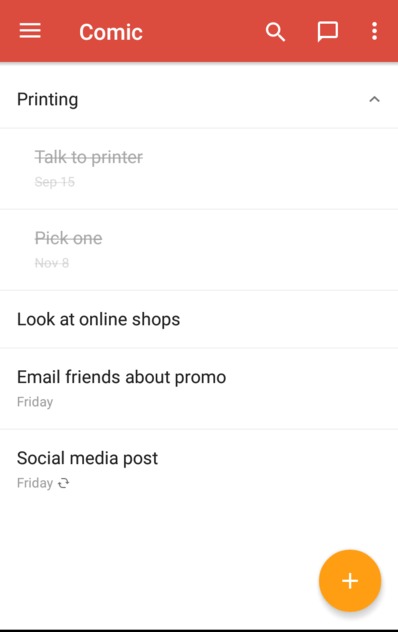How To Be Productive

Disclaimer: Obviously your personal health should come before anything else. This section is meant to help you increase your productivity when you’re feeling unmotivated, but if you’re ever feeling exhausted or overworked, I encourage you to take as many breaks as you need. I truly can’t emphasize this enough. Your health matters and you deserve all the time you need to take care of yourself.
Being productive is massively important. Now, I don’t necessarily believe in the “do a little every day” mentality (again your personal health should come first), but if you’re never putting pen to paper (or to tablet) you’re not going to finish your story.
I was invited onto the Comix Launch podcast to talk about how to turn procrastination into productivity. You can listen to the full episode here if that interests you.
General tips
Here are a few tips to help you stay productive:
-
Build a schedule and stick to it. If you have designated writing time during the day (say, 6-8 PM), you’ll develop a routine and be more likely to stay focused on writing during that time period.
-
Similarly, have a designated work spot. If you work in the same place you sleep and watch cat videos, you’re going to have trouble staying focused on your work. If you take a break, leave your work spot.
-
Block out access to distractions. Unplug your TV, disconnect from the internet, disable social media notifications, clear everything except your work from the room… There are many ways to force yourself to stay on task. You could even download an app blocker like Cold Turkey that shuts you out from certain programs temporarily while you work, or Forest that grows trees on your phone while you stay productive.
-
Be accountable to someone. It’s easy to justify to yourself that you can take a week off from writing (and absolutely you should if you feel that’s what’s best for you), but if you really do want to be productive, and that week off turns into a month off, well then you have yourself a problem. Whether it be your mom, your friend, your Twitter followers or a fellow writer, make sure someone other than you knows you’re trying to make a comic. By forcing yourself to give daily, or weekly, or monthly updates to someone about your progress, you’ll feel more obligated to finish your work. If you have one, (and I highly suggest you do) you can use your e-mail list for this purpose. Not only will it help you to maintain progress but it will also provide the opportunity to give updates to your followers.
-
Give your project an approximate deadline. Deadlines are another way of keeping yourself accountable in your projects. Lots of people set out to make a comic but a year later they’ve made next to no progress because they didn’t have a date in mind they wanted it to be complete by. Of course, there will be unforseen things that come up which may require you to shift your date, but just having a date in mind will help you visualize your schedule and give you a reference point to see how you’re progressing. Here’s a wonderful tool for helping you plan out how long it will take to finish your comic.
-
Create a to-do list and break your project into workable chunks. Making a comic can seem like a daunting task. By breaking things down into workable chunks (ink page 1, apply to publisher X, sort out the project budget…) you can make sure you’re always progressing towards your goal. Some digital lists that you can get on your phone and computer are Todoist or Workflowy (or Omnifocus if you have mac or iPhone). If you’re looking for a more fun approach, try turning your list into a real life role playing game with Habitica.
I HIGHLY recommend you check out this spreadsheet by Reed Black that breaks down the process of writing, drawing, colouring and lettering a comic into one big todo list.
-
Don’t just give yourself one big deadline, give your to-do items deadlines too. By setting a specific done date for each task, you can pace yourself throughout the entire process, making sure you are set up to be constantly progressing without overwhelming yourself with the stress of that final looming due date.
-
Reward yourself with breaks. If you’re trying to become less of a procrastinator, you can’t expect to be able to just jump into a schedule. You need to take it one step at a time, rewarding yourself to each bit of progress that you make. When I first started, I worked half an hour on, five minutes off. In those five minutes I rewarded myself by watching a short YouTube video and by doing so, I built an association in my head between being productive and getting to relax. Once I got that down consistently, I quickly started desiring more work because I knew it meant more relaxation time! I then began to gradually increase the intervals. Now I work about two hours on, fifteen minutes off, without issue. (Well, usually. I still catch myself doom scrolling from time to time, but meh, nobody is perfect.)
Approaches to productivity

Okay you’ve set yourself up properly and broken down your tasks. Now it’s time to start actually working on them! I’ve tested out two different approaches to tackling to-do items and I found that each had their benefits and drawbacks:
The first approach I attempted was to assign each to-do item to a day.
I forced myself to complete each of the tasks assigned that day, no matter how long it took. This let me determine exactly how much work I was going to get done on any given day allowing me to quite accurately predict where I would be at the end of the week (or even the month).
The drawback was that my work hours were unpredictable. I ended up working late into the night on some days just to catch up to where I was expecting to be. This made it much harder to manage time off and I took a hit to my mental health.
After a while of this, I decided to try something new.
My second approach attempted to mitigate the previous problem by instead designating specific work hours each day.
I decided that I would work every weekday from 7 PM until midnight no matter how much I got done. Each day I would pick up whichever tasks were most pressing and work on those for five hours. This approach let me be in control of my time, allowing me to dedicate a specific portion of my schedule to comic work. The fixed hours also meant that I wouldn’t overwork myself and allowed me to more easily switch my thinking brain off at the end of the day. This was a gift to my mental health.
Unfortunately, this approach meant that I was less sure of what I’d end up completing each day. It also required more discipline as I was no longer working against a specific deadline for each to-do item.
If you don’t know where to start, I suggest starting with the first approach. It forces you to be productive, which I found essential when first starting out. I do encourage you to test out both approaches however, and stick with whichever combination of the two works best for you (and of course if you find an alternate approach that works better, go for it).
It’s important to remember that productivity isn’t something you can master right away. It takes time to train yourself into the right mindset, so don’t be discouraged if you don’t get immediate results. Start small and reward yourself for your successes. You’ll get there.
And again, just to reiterate: Your health should always come first. Productivity is important, but your personal well being should always trump that. Take that time off if you need it. You deserve it!
Table of Contents
Intro
Before You Start
Writing
- Overview
- It All Starts With An Idea
- Thought Dumping
- Outlining
- World Building
- Characters
- Writing Scenes
- Breaking Scenes Down
- Scripts
- Dialogue
- Revision
- Choosing A Title
- Writer's Block
Hiring A Team
- Overview
- Sorting Out Your Budget
- Writing A Solicitation
- Where To Find Your Team
- What Makes A Good Partner
- Contracts
Drawing
Colouring
Lettering
- Overview
- General Tips
- Standard Black vs Rich Black
- Choosing A Font
- Font Types
- When To Bold Text
- Sound Effects
Marketing
Publishing
Printing
- Overview
- Getting Print Ready Files
- Offset vs Digital Printers
- Why Page Count Matters
- Book Formats And Binding Types
- How Many Copies To Print
- Aesthetics
- Tips For Saving Money
- Printer Comparison Table